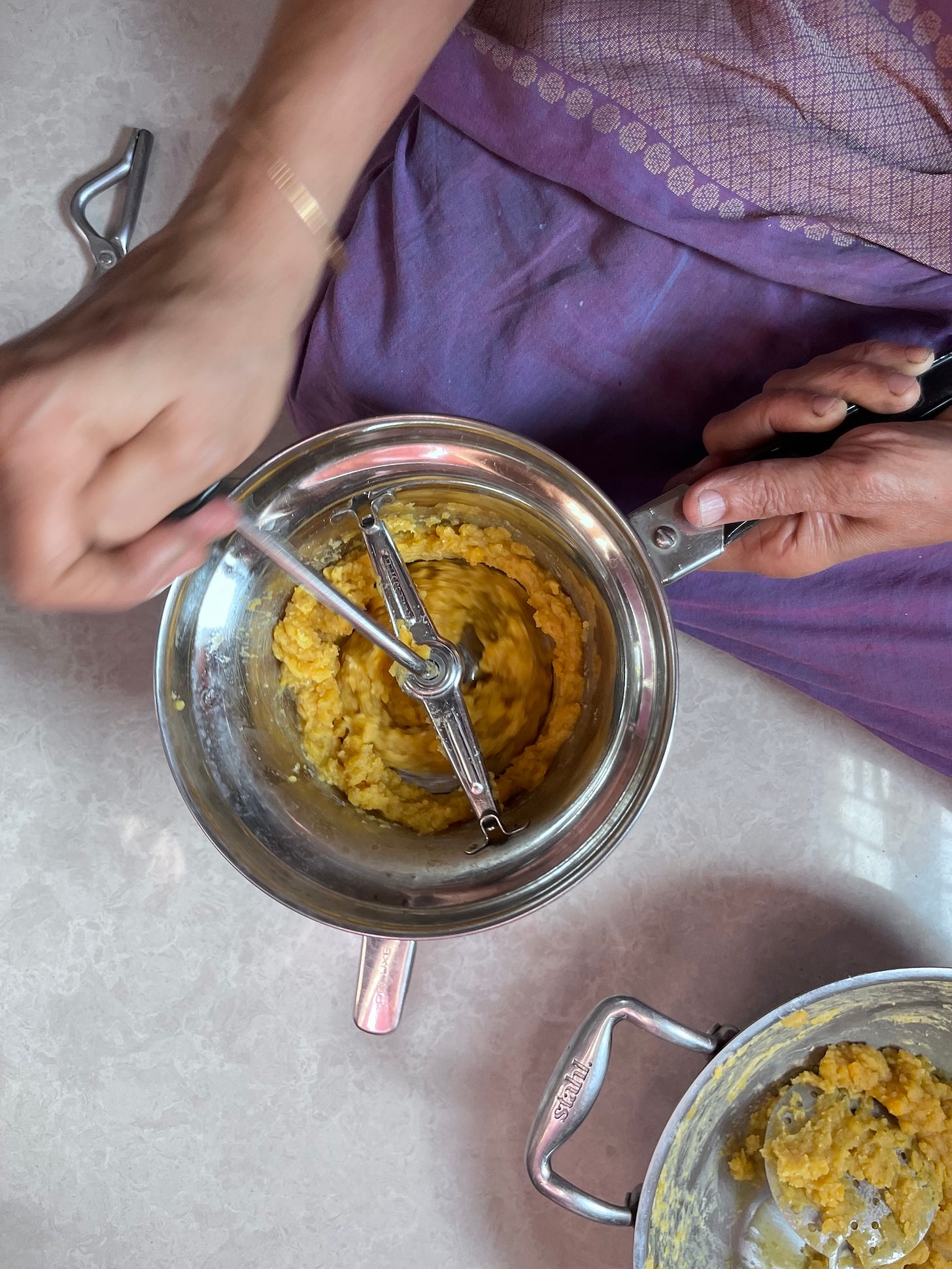Failing recipe writing
How can you have rules for something so ephemeral and unambiguous?
Hello and welcome back to shelf offering, a newsletter by me, Apoorva Sripathi – writer, editor, and artist. shelf offering is published three out of four Tuesdays a month, unless I’m taking a break. If you think my work is valuable and would like to support me, follow 💌shelfoffering on Instagram, share this post, and consider becoming a paid subscriber. Thank you.
When I write and send out recipes for my newsletter (and for other publications), I don’t really have anyone in mind. I usually rediscover a dish I’ve made recently, make it a few more times, note down the approximate quantities of ingredients on my phone, and later assemble it all together on the page by hand. Then it goes on the computer where I type and edit, It’s a pretty hodgepodge effort but it always comes together. I know that this might make professional cooks and recipe writers shudder, but this is my approach and it has worked out for me.
I have always been an intuitive cook, much of my agility in the kitchen comes from watching other people cook. I’ve applied this to other areas of my life too. I used to watch the designers at work making pages on indesign or CCI swiftly moving columns, or on photoshop using the lasso tool to carefully but adeptly isolate an object, and two days later, I was doing the same. What can I say I’m a quick learner. I’ve observed my grandfather bind a book with the needle used to stitch together those gunny sacks and I instinctively know how to do it now. I’ve internalised how to cook since I was 13 and it’s become second nature. I thrive in the kitchen. I still use recipes though – my first formal recipe was Nigella’s for a salad. I don’t remember which one exactly but I do remember being introduced to the concept of a salad dressing, which up until that point was alien to me and my family. We just cut up cucumbers, onions, tomatoes, with some boiled peanuts and shredded coconut plus some finely chopped green chillies topped with the juice from a lemon, salt, and handfuls of fresh coriander and called it a day. Some days my mother would add pearls of pomegranate, which she would consult from her recipe book, which was a tattered blue diary filled with recipes from her coworkers, friends, cooking programmes from television, or from other tiny recipe inserts in Tamil periodicals.
When people (read my sister) ask me for recipes and when I ask her for one, we send each other voice notes: ‘take like two onions, some garlic, ginger, green chillies, chop this, grind that etc etc…’ It is also mostly in Tamil. We share photos of what we’ve made and exchange feedback. ‘More salt, more chilli (always), maybe a pinch of sugar?’ It is easy to dictate, to tell, to advice recipes. I find writing them the hard part sometimes.
I can trust myself to skip a few steps and come back to them later knowing it will work, however the (written) recipe cannot wait. Neither can other people. I write this way too – newsletters, other essays, poetry, construct crosswords – start strong and then just figure it out. I think that this method, in writing, working, drawing, leans towards embracing failures. I’ve become confident in the mistakes, learnt to scavenge something valuable from the rubble of imperfections, and as well, walk away when things don’t go as I’d hoped. Translating this into a recipe, exhorting that one does the same as I do is challenging.
So how can recipe writing be considered universal and standardised when it’s personal – personal to the recipe writer who gives birth to it and personal to the cook who will later mould it into their own? I routinely struggle with this; in fact, I was so against writing recipes initially that I only gave in because I thought that it would be a good writing challenge for me to take on. Of course, this is the unique challenge with food itself - it is both universal and personal. Which, I think, renders it to be lawless. How can you have rules for something so ephemeral and unambiguous? This is what sets me up to fail when I write recipes.
My voice and my words on the page are accumulations of years of eating, cooking, trying, failing, and succeeding. They are embodied and engineered by my past and present selves with “plenty of room for idiosyncrasies” – a phrase by Molly O’ Neill for her essay Food Porn which I’m borrowing for mine about recipe writing. So meta. Or as Alicia Kennedy writes, Why cook a recipe if you don’t understand the writer’s appetite?” I want to add on to Alicia’s question here – how do you understand the reader’s appetite?
I ask and I answer: You don’t. I think it’s best that I don’t. Because that would mean carefully curating dishes and recipes that cater to a vast swathe of people who do or don’t exist. And worse, it means dipping into the swimming pool of trending ingredients, flavours, and experiences which are far from esoteric and just so ordinary. When there is talk of a global pantry, I can only cringe hard: for whom is this global, ingredients such as matcha, curry leaves, miso, pistachio chocolate, ube? For whom is this already present, a part of their lived truths and palates? For whom is this commodity and performance? And for whom is this consumerist cosmology?
This means that recipe writing is fickle by nature. An amount of salt that is acceptable to me is tame to some, a salty mess to others. Forget conversions, I have trouble telling people how to salt because the difference between delicious and mush is the right amount of salt. I can’t help but write into my recipes, an addendum to salt as you go, taste as you salt. Or to start with 1/2 teaspoon of salt and increase gradually, tasting as you go. I seldom want to give out precise measurements but a recipe text has to be as accurate as possible, both personal and universal, simple and familiar. So again, I have failed at writing recipes. But I do take this act seriously. A recipe is primarily a set of instructions; it is also storytelling. The end is a steaming dish in front of me but why can’t I take the scenic route there? Why can’t I ask others to do it too?
If cooking is a kind of occult magic then the recipe is a guide, escorting you through it – it is the cook’s job to make that trick their own, accepting mistakes and learning to salvage what has been left in the glowing embers. The recipe then has to be generous and accommodating – helping make room for the non-believers and for those who let their instincts lead the way. Rebecca May Johnson writes about this in Small Fires: ‘The recipe text provides a space, a framework which constrains and instructs but also nurtures and releases the voice of the cook. And the tension between a recipe text and the cook does not end in domination. A recipe can usually be set aside if desires. The decision of the cook to respond to a recipe, to cook with it, is also a kind of tribute.”
After the tribute, comes the exhaustion with cooking itself sometimes. After all, both cooking and recipe writing are acts of performance, they are overwhelmingly about the self, they often soothe anxieties about what to make for dinner (whether one follows the text till the end or not). I mean I get it. There are days when I only want to eat toast and butter, soft khichdi with pickle, ghee and yogurt, or simply my mother’s cooking. These are days I don’t want to cook, to perform, or be back to myself, and simply consider food as work. But that would be denying any responsibility for my part in the food system. I cannot, and no one can, do this in solitude. So what is a recipe for? It is an antidote to recover back to myself countless times, over and over again. A recipe is simply real life.






I don't think of recipes as setting out rules...at best they are guidance, encouragement, inspiration. And you seem to be of the same mind☀️☀️
“If cooking is a kind of occult magic then the recipe is a guide, escorting you through it – it is the cook’s job to make that trick their own, accepting mistakes and learning to salvage what has been left in the glowing embers. The recipe then has to be generous and accommodating – helping make room for the non-believers and for those who let their instincts lead the way.”
And
“After all, both cooking and recipe writing are acts of performance, they are overwhelmingly about the self, they often soothe anxieties about what to make for dinner (whether one follows the text till the end or not). I mean I get it. There are days when I only want to eat toast and butter, soft khichdi with pickle, ghee and yogurt, or simply my mother’s cooking. These are days I don’t want to cook, to perform, or be back to myself, and simply consider food as work. But that would be denying any responsibility for my part in the food system. I cannot, and no one can, do this in solitude. So what is a recipe for? It is an antidote to recover back to myself countless times, over and over again. A recipe is simply real life.”